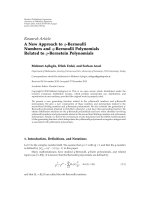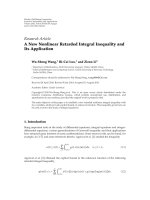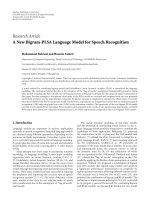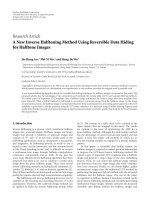Báo cáo hóa học: " Research Article A New Subclass of Analytic Functions Defined by Generalized Ruscheweyh Differential Operator" potx
Bạn đang xem bản rút gọn của tài liệu. Xem và tải ngay bản đầy đủ của tài liệu tại đây (485.63 KB, 12 trang )
Hindawi Publishing Corporation
Journal of Inequalities and Applications
Volume 2008, Article ID 134932, 12 pages
doi:10.1155/2008/134932
Research Article
A New Subclass of Analytic Functions Defined by
Generalized Ruscheweyh Differential Operator
Serap Bulut
Civil Aviation College, Kocaeli University, Arslanbey Campus, 41285
˙
Izmit-Kocaeli, Turkey
Correspondence should be addressed to Serap Bulut,
Received 1 July 2008; Accepted 3 September 2008
Recommended by Narendra Kumar Govil
We investigate a new subclass of analytic functions in the open unit disk
U which is defined by
generalized Ruscheweyh differential operator. Coefficient inequalities, extreme points, and the
integral means inequalities for the fractional derivatives of order p η 0 ≤ p ≤ n, 0 ≤ η<1
of functions belonging to this subclass are obtained.
Copyright q 2008 Serap Bulut. This is an open access article distributed under the Creative
Commons Attribution License, which permits unrestricted use, distribution, and reproduction in
any medium, provided the original work is properly cited.
1. Introduction
Throughout this paper, we use the following notations:
N : {1, 2, 3, },
N
0
: N ∪{0},
R
−1
: {u ∈ R : u>−1},
R
0
−1
: R
−1
\{0}.
1.1
Let A denote the class of all functions of the form
fzz
∞
n2
a
n
z
n
, 1.2
which are analytic in the open unit disk U : {z ∈ C : |z| < 1}.
For f
j
∈Agiven by
f
j
zz
∞
n2
a
n,j
z
n
j 1, 2, 1.3
2 Journal of Inequalities and Applications
the Hadamard product or convolution f
1
∗f
2
of f
1
and f
2
is defined by
f
1
∗f
2
zz
∞
n2
a
n,1
a
n,2
z
n
. 1.4
Using the convolution 1.4, Shaqsi and Darus 1 introduced the generalization of the
Ruscheweyh derivative as f ollows.
For f ∈A,λ≥ 0, and u ∈ R
−1
, we consider
R
u
λ
fz
z
1 − z
u1
∗R
λ
fzz ∈ U, 1.5
where R
λ
fz1 − λfzλzf
z,z∈ U.
If f ∈Ais of the form 1.2, then we obtain the power series expansion of the form
R
u
λ
fzz
∞
n2
1 n − 1λCu, na
n
z
n
, 1.6
where
Cu, n
1 u
n−1
n − 1!
n ∈ N, 1.7
and where a
n
is the Pochhammer symbol or shifted factorial defined in terms of the
Gamma function by
a
n
:
Γa n
Γa
1, if n 0,a∈ C \{0},
aa 1 ···a n − 1, if n ∈ N,a∈ C.
1.8
In the case m ∈ N
0
, we have
R
m
λ
fz
zz
m−1
fz
m
m!
, 1.9
and for λ 0, we obtain uth Ruscheweyh derivative introduced in 2, R
m
0
R
m
.
Using the generalized Ruscheweyh derivative operator R
u
λ
, we define the following
classes.
Definition 1.1. Let S
λ
u, v; α be the class of functions f ∈Asatisfying
Re
R
u
λ
fz
R
v
λ
fz
>α 1.10
for some 0 ≤ α<1,u∈ R
0
−1
,v∈ R
−1
,λ≥ 0, and all z ∈ U.
Serap Bulut 3
In this paper, basic properties of the class S
λ
u, v; α are studied, such as coefficient
bounds, extreme points, and integral means inequalities for the fractional derivative.
2. Coefficient inequalities
Theorem 2.1. Let 0 ≤ α<1,u∈ R
0
−1
,v∈ R
−1
, and λ ≥ 0.Iff ∈Asatisfies
∞
n2
B
n
u, v, α|a
n
|≤21 − α, 2.1
where
B
n
u, v, α :1 n − 1λ{|Cu, n − 1 αCv, n| Cu, n1 − αCv, n}, 2.2
then f ∈S
λ
u, v; α.
Proof. Let 2.1 be true for 0 ≤ α<1,u∈ R
0
−1
,v∈ R
−1
,andλ ≥ 0. For f ∈A, define the
function F by
Fz :
R
u
λ
fz
R
v
λ
fz
− α. 2.3
It is sufficient to show that
Fz − 1
Fz1
< 1 2.4
for z ∈ U.
So, we have
Fz − 1
Fz1
R
u
λ
fz − 1 αR
v
λ
fz
R
u
λ
fz1 − αR
v
λ
fz
α −
∞
n2
1 n − 1λCu, n − 1 αCv, na
n
z
n−1
2 − α
∞
n2
1 n − 1λCu, n1 − αCv, na
n
z
n−1
≤
α
∞
n2
1 n − 1λ|Cu, n − 1 αCv, n||a
n
||z|
n−1
2 − α −
∞
n2
1 n − 1λCu, n1 − αCv, n|a
n
||z|
n−1
<
α
∞
n2
1 n − 1λ|Cu, n − 1 αCv, n||a
n
|
2 − α −
∞
n2
1 n − 1λCu, n1 − αCv, n|a
n
|
< 1 by 2.1.
2.5
Therefore, f ∈S
λ
u, v; α.
4 Journal of Inequalities and Applications
Theorem 2.2. If f ∈S
λ
u, v; α,then
|a
n
|≤
21 − α
1 n − 1λ|Cu, n − Cv, n|
n−1
u1
1 n − u − 1λCv, n − u|a
n−u
| 2.6
for n ≥ 2,witha
1
1.
Proof. Define the function
Gz :
1
1 − α
R
u
λ
fz
R
v
λ
fz
− α
: 1
∞
n1
a
n
z
n
. 2.7
Since Re{Gz} > 0, we get
|a
n
|≤2 2.8
for n 1, 2,
From the definition of Gz,weobtain
R
u
λ
fz − αR
v
λ
fz
1 − α
R
v
fz
1
∞
n1
a
n
z
n
. 2.9
So, by 1.6, we have
z
1 λ
1 − α
Cu, 2 − αCv, 2a
2
z
2
1 2λ
1 − α
Cu, 3 − αCv, 3a
3
z
3
···
z a
1
z
2
a
2
z
3
a
3
z
4
···
1 λCv, 2a
2
z
2
1 λCv, 2a
2
a
1
z
3
1 λCv, 2a
2
a
2
z
4
···
1 2λCv, 3a
3
z
3
1 2λCv, 3a
3
a
1
z
4
···
2.10
or
z
1 λ
1 − α
Cu, 2 − Cv, 2a
2
z
2
1 2λ
1 − α
Cu, 3 − Cv, 3a
3
z
3
···
z a
1
z
2
1 λCv, 2a
2
a
1
a
2
z
3
1 2λCv, 3a
3
a
1
1 λCv, 2a
2
a
2
a
3
z
4
···
2.11
Serap Bulut 5
or, equivalently,
z
∞
n2
1 n − 1λ
1 − α
Cu, j − Cv, ja
n
z
n
z
∞
n2
n−1
u1
1 n − u − 1λCv, n − ua
n−u
a
u
z
n
.
2.12
When we consider the coe fficients of z
n
of both series in the above equality, we have
a
n
1 − α
1 n − 1λCu, n − Cv, n
n−1
u1
1 n − u − 1λCv, n − ua
n−u
a
u
. 2.13
Therefore,
|a
n
|≤
1 − α
1 n − 1λ|Cu, n − Cv, n|
n−1
u1
1 n − u − 1λCv, n − u|a
n−u
||a
u
|
≤
21 − α
1 n − 1λ|Cu, n − Cv, n|
n−1
u1
1 n − u − 1λCv, n − u|a
n−u
|,
2.14
since |a
u
|≤2, u 1, 2, .
3. Extreme points
Definition 3.1. Let
S
λ
u, v; α be the subclass of S
λ
u, v; α which consists of function
fzz
∞
n2
a
n
z
n
a
n
≥ 03.1
whose coefficients satisfy inequality 2.1.
Theorem 3.2. Let f
1
zz and
f
k
zz
21 − α
B
k
u, v, α
z
k
k 2, 3, , 3.2
where B
k
u, v, α is given by 2.2.
6 Journal of Inequalities and Applications
Then f ∈
S
λ
u, v; α if and only if it can be expressed in the form
fz
∞
k1
δ
k
f
k
z, 3.3
where δ
k
≥ 0 and
∞
k1
δ
k
1.
Proof. Assume that
fz
∞
k1
δ
k
f
k
z. 3.4
Then
fzδ
1
f
1
z
∞
k2
δ
k
f
k
z
δ
1
z
∞
k2
δ
k
z
21 − α
B
k
u, v, α
z
k
∞
k1
δ
k
z
∞
k2
δ
k
21 − α
B
k
u, v, α
z
k
z
∞
k2
δ
k
21 − α
B
k
u, v, α
z
k
.
3.5
Thus
∞
k2
δ
k
21 − α
B
k
u, v, α
B
k
u, v, α21 − α
∞
k2
δ
k
21 − α1 − δ
1
≤ 21 − α. 3.6
Therefore, we have f ∈
S
λ
u, v; α.
Conversely, suppose that f ∈
S
λ
u, v; α. Since
a
k
≤
21 − α
B
k
u, v, α
k 2, 3, , 3.7
we can set
δ
k
:
B
k
u, v, α
21 − α
a
k
k 2, 3, ,
δ
1
: 1 −
∞
k2
δ
k
.
3.8
Serap Bulut 7
Then
fzz
∞
k2
a
k
z
k
∞
k1
δ
k
z
∞
k2
δ
k
21 − α
B
k
u, v, α
z
k
δ
1
z
∞
k2
δ
k
z
21 − α
B
k
u, v, α
z
k
δ
1
f
1
z
∞
k2
δ
k
f
k
z
∞
k1
δ
k
f
k
z.
3.9
This completes the proof of Theorem 3.2.
Corollary 3.3. The extreme points of
S
λ
u, v; α are given by
f
1
zz, f
k
zz
21 − α
B
k
u, v, α
z
k
k 2, 3, , 3.10
where B
k
u, v, α is given by 2.2.
4. The main integral means inequalities for the fractional derivative
We discuss the integral means inequalities for functions f ∈
S
λ
u, v; α.
The following definitions of fractional derivatives by Owa 3also by Srivastava and
Owa 4 will be required in our investigation.
Definition 4.1. The fractional derivative of order η is defined, for a function f,by
D
η
z
fz
1
Γ1 − η
d
dz
z
0
fξ
z − ξ
η
dξ 0 ≤ η<1, 4.1
where the function f is analytic in a simply connected region of the complex z-plane
containing the origin, and the multiplicity of z − ξ
−η
is removed by requiring logz − ξ
to be real when z − ξ>0.
Definition 4.2. Under the hypothesis of Definition 4.1, the fractional derivative of order p η
is defined, for a function f,by
D
pη
z
fz
d
p
dz
p
D
η
z
fz, 4.2
where 0 ≤ η<1andp ∈ N
0
.
8 Journal of Inequalities and Applications
It readily follows from 4.1 in Definition 4.1 that
D
η
z
z
k
Γk 1
Γk 1 − η
z
k−η
0 ≤ η<1,k∈ N. 4.3
We will also need the concept of subordination between analytic functions and a
subordination theorem of Littlewood 5 in our investigation.
Definition 4.3. Given two functions f and g, which are analytic in U, the function f is said to
be subordinate to g in U if there exists a function w analytic in U with
w00, |wz| < 1 z ∈ U, 4.4
such that
fzgwz z ∈ U. 4.5
We denote this subordination by
fz ≺ gz. 4.6
Lemma 4.4. If the functions f and g are analytic in U
with
fz ≺ gz, 4.7
then, for μ>0 and z re
iθ
0 <r<1,
2π
0
|fz|
μ
dθ ≤
2π
0
|gz|
μ
dθ. 4.8
Our main theorem is contained in the following.
Theorem 4.5. Let f ∈
S
λ
u, v; α and suppose that
∞
n2
n − p
p1
a
n
≤
21 − αΓk 1Γ3 − η − p
B
k
u, v, αΓk 1 − η − pΓ2 − p
4.9
for 0 ≤ p ≤ n, k ≥ p, 0 ≤ η<1,wheren − p
p1
denotes the Pochhammer symbol defined by
n − p
p1
n − pn − p 1 ···n. 4.10
Also let the function f
k
be defined by
f
k
zz
21 − α
B
k
u, v, α
z
k
k 2, 3, . 4.11
Serap Bulut 9
If there exists an analytic function w defined by
wz
k−1
:
B
k
u, v, αΓk 1 − η − p
21 − αΓk 1
∞
n2
n − p
p1
Ψna
n
z
n−1
4.12
with
Ψn
Γn − p
Γn 1 − η − p
, 0 ≤ η<1,n 2, 3, , 4.13
then, for μ>0 and z re
iθ
0 <r<1,
2π
0
D
pη
z
fz
μ
dθ ≤
2π
0
D
pη
z
f
k
z
μ
dθ, 0 ≤ η<1. 4.14
Proof. By means of 4.3 and Definition 4.2,wefindfrom3.1 that
D
pη
z
fz
z
1−η−p
Γ2 − η − p
1
∞
n2
Γ2 − η − pΓn 1
Γn 1 − η − p
a
n
z
n−1
z
1−η−p
Γ2 − η − p
1
∞
n2
Γ2 − η − pn − p
p1
Ψna
n
z
n−1
,
4.15
where
Ψn
Γn − p
Γn 1 − η − p
, 0 ≤ η<1,n 2, 3, . 4.16
Since Ψ is a decreasing function of n,weget
0 < Ψn ≤ Ψ2
Γ2 − p
Γ3 − η − p
. 4.17
Similarly, from 4.11, 4.3,andDefinition 4.2, we have
D
pη
z
f
k
z
z
1−η−p
Γ2 − η − p
1
21 − α
B
k
u, v, α
Γ2 − η − pΓk 1
Γk 1 − η − p
z
k−1
. 4.18
10 Journal of Inequalities and Applications
For μ>0andz re
iθ
0 <r<1, we want to show that
2π
0
1
∞
n2
Γ2 − η − pn − p
p1
Ψna
n
z
n−1
μ
dθ
≤
2π
0
1
21 − α
B
k
u, v, α
Γ2 − η − pΓk 1
Γk 1 − η − p
z
k−1
μ
dθ.
4.19
So, by applying Lemma 4.4, it is enough to show that
1
∞
n2
Γ2 − η − pn − p
p1
Ψna
n
z
n−1
≺ 1
21 − α
B
k
u, v, α
Γ2 − η − pΓk 1
Γk 1 − η − p
z
k−1
.
4.20
If the above subordination holds true, then we have an analytic function w with w00and
|wz| < 1 such that
1
∞
n2
Γ2 − η − pn − p
p1
Ψna
n
z
n−1
1
21 − α
B
k
u, v, α
Γ2 − η − pΓk 1
Γk 1 − η − p
wz
k−1
.
4.21
By the condition of the theorem, we define the function w by
wz
k−1
B
k
u, v, αΓk 1 − η − p
21 − αΓk 1
∞
n2
n − p
p1
Ψna
n
z
n−1
, 4.22
which readily yields w00. For such a function w, we have
|wz|
k−1
≤
B
k
u, v, αΓk 1 − η − p
21 − αΓk 1
∞
n2
n − p
p1
Ψna
n
|z|
n−1
≤|z|
B
k
u, v, αΓk 1 − η − p
21 − αΓk 1
Ψ2
∞
n2
n − p
p1
a
n
|z|
B
k
u, v, αΓk 1 − η − p
21 − αΓk 1
Γ2 − p
Γ3 − η − p
∞
n2
n − p
p1
a
n
≤|z| < 1
4.23
by means of the hypothesis of the theorem.
Thus the theorem is proved.
As a special case p 0, we have the following result from Theorem 4.5.
Serap Bulut 11
Corollary 4.6. Let f ∈
S
λ
u, v; α and suppose that
∞
n2
na
n
≤
21 − αΓk 1Γ3 − η
B
k
u, v, αΓk 1 − η
k 2, 3, . 4.24
If there exists an analytic function w defined by
wz
k−1
B
k
u, v, αΓk 1 − η
21 − αΓk 1
∞
n2
nΨna
n
z
n−1
4.25
with
Ψn
Γn
Γn 1 − η
, 0 ≤ η<1,n 2, 3, , 4.26
then, for μ>0 and z re
iθ
0 <r<1,
2π
0
D
η
z
fz
μ
dθ ≤
2π
0
D
η
z
f
k
z
μ
dθ, 0 ≤ η<1. 4.27
Letting p 1inTheorem 4.5, we have the f ollowing.
Corollary 4.7. Let f ∈
S
λ
u, v; α and suppose that
∞
n2
nn − 1a
n
≤
21 − αΓk 1Γ2 − η
B
k
u, v, αΓk − η
k 2, 3, . 4.28
If there exists an analytic function w defined by
wz
k−1
B
k
u, v, αΓk − η
21 − αΓk 1
∞
n2
nn − 1Ψna
n
z
n−1
4.29
with
Ψn
Γn − 1
Γn − η
, 0 ≤ η<1,n 2, 3, , 4.30
then, for μ>0 and z re
iθ
0 <r<1,
2π
0
D
1η
z
fz
μ
dθ ≤
2π
0
D
1η
z
f
k
z
μ
dθ, 0 ≤ η<1. 4.31
12 Journal of Inequalities and Applications
References
1 K. A. Shaqsi and M. Darus, “On univalent functions with respect to K-symmetric points given by a
generalised Ruscheweyh derivatives operator,” submitted.
2 S. Ruscheweyh, “New criteria for univalent functions,” Proceedings of the American Mathematical Society,
vol. 49, no. 1, pp. 109–115, 1975.
3 S. Owa, “On the distortion theorems. I,” Kyungpook Mathematical Journal, vol. 18, no. 1, pp. 53–59, 1978.
4 H. M. Srivastava and S. Owa, Eds., Univalent Functions, Fractional Calculus, and Their Applications, Ellis
Horwood Series in Mathematics and Its Applications, Ellis Horwood, Chichester, UK; John Wiley &
Sons, New York, NY, USA, 1989.
5 J. E. Littlewood, “On inequalities in the theory of functions,” Proceedings of the London Mathematical
Society, vol. 23, no. 1, pp. 481–519, 1925.









